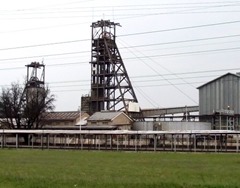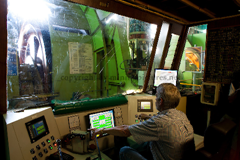A mechanical engineering paper, some history and memories
I was digging in my bookshelf and came across the 80th Anniversary Association of Mine Resident Engineers, Papers and Discussions Commemorative Edition (May 2004). Within it's dark covers, is a paper I wrote many years ago. Reading through the paper, brought memories of my arrival in South Africa. It seemed a shame to lose them all again; so this is my first off-topic post in a while.
Background
 Mine Shaft Headgear - South Africa.
Mine Shaft Headgear - South Africa.
You can see the steel ropes from the
winding house over the headgear
wheels and to the conveyance.
After graduation in 1985, I found myself on a plane to South Africa having been offered a position at GENCOR [General Mining Union Corporation]. After landing, I was taken to Stilfontein, a small mining town and spent several weeks on the adjacent mines being instructed in how everything works.
As a newly graduated engineer, working on a mine was an interesting experience. A particular memory was being impressed with the quantity and size of the mine winding gear on the surface, descending 2 km underground, taking a small diesel train and being really impressed on finding a cavern with another full set of mine winding equipment to take you down a further 2 km. If anyone ever has the opportunity to visit a large production mine, don't miss it, they really are an eye opener in terms of the scale of operations.
After Stilfontein, I shipped off for a couple of months at the companies head office in Johannesburg to get a feel for that side of the operations. Following this, my next stop was a longer stint at Buffelsfontien mine to finish the rest of my training.
GENCOR did have a well thought out training program, and it was a great opportunity for new engineers to get direct practical experience. All graduate engineers would spend around two years learning, gaining experience and generally getting settled in to the mining environment. In addition, everyone was studying to take and pass the all important Certificate of Competency on the Mines and Works Act of 1956. Once you passed this exam, the training ended and you were thrown in the deep end; by being made operationally and legally response as a section engineer for a real in production shaft - in my case No. 1 and 3. shafts at Winkelhaak mines.
It was during my training at Buffelsfontein that the Resident Engineer, JE Robinson, asked me to write a report on the emergency braking of mine winders. After spending some time researching and putting this together, I handed it in. What followed was a little unexpected.
Mine Winders
_thumb.jpg) Double Drum Rock Winder
Double Drum Rock Winder
- South Deep Mine, South Africa
Mine Winders at the heart of the people, rock and material hosting systems on a mine.
Imagine 2 km of steel rope wound round a large drum and connected to the top of the conveyance in the shaft.
Large motors are used to turn the drums to host the conveyance. In addition, friction brakes and safety mechanisms complete the arrangement
Apparently this was a task that had been given to new engineers for a long time. Most engineers would revert to the Electric Winders book, which was considered the be all and end all of mine winding. They would then reproduce the books contents from the appropriate section. Apparently, I was the first engineer to look at this problem from first principals and derive all the equations.
Electric Winders - A manual on the Design, Construction, Application and Operation of Winding Engines and Mine Hoists
by H H Broughton: Spon 1948.
The resident engineer was impressed enough to decide he wanted to present the report to the Association of Mine Resident Engineers annual meeting. It was also enough to get permission to experiment (play) with a real working winder and have use of a then valuable standalone computer.
Research and Writing the Paper
 Operating a mine winder
Operating a mine winder I've always liked analysing systems and working things out from first principals. For example, I don't think I ever made the effort to memorise linear equations of motion - it was always more natural to consider the differential forms and use those to solve any problem. In a way, I think my memory is not a good as some people, but the ability to derive solutions from first principals makes up for that. Anyhow, it was logical that I start my analysis in this way. I did make reference to the Electric Winders book, but it was more to see if I could derive the same equations and to help verify that was I was doing was correct.
This was the age of personal computers for everyone, so my working and the report was done by hand. I'm sure I had to rewrite it many times; something I would not want to do now. I'm not going to detail the equations or approach; a copy of the paper is attached to this post if your interested. Having researched and wrote the initial paper and given it to the resident engineer, I had two follow on tasks - verifying the derived equations by experiment and then having the report typed.
This was around the same time when I tinkering with my Commodore 64 (if you don't know, consider yourself lucky to be young). Luckily the mine also had HP computers of probably the same processing power. I was allowed to have one, complete with six inch display and a small thermal printer, with which to do my work. Unfortunately, I can't remember the exact machine, but it was good enough anyhow.
_thumb.jpg) HP 85B, 0.6 MHz 64 K RAM Computer
HP 85B, 0.6 MHz 64 K RAM Computer
[maybe not exactly this model of
computer, but pretty similar]
I programmed to equations into the computer using basic and arranged some actual testing on a mine winder. Fortunately during the testing I had a lot of support as everyone was interested in what I was doing; it was unusual in those days for people to be wondering around with a computer and printing out things. Compared to modern programming (myelectrical.com for example), looking back it was pretty basic stuff – but impressive at the time.
The good news was that the actual test results really did match my calculations. I guess I was relieved and a little surprised. It is one thing to write things on paper, another to know that several tonnes of equipment driven by complex machinery and hurtling at up to 65 km/hr down a 2 km deep shaft behaves as expected.
_thumb.png) Calculated compared to measured results
Calculated compared to measured results After writing the report and verifying all this by experiment, the final activity was typing. The secretary was great in this, and a little to my shame I cannot remember her name. She spend a lot of time on the report, and it wasn't easy. I remember her using a daisy writer typewriter and patiently swapping disks to change between roman and Greek characters.
Finally it was all completed, presented to the Association of Mine Engineers. I then continued with my life and forgot all about it. It was around 2008 that I came across the reference on the internet and found out the paper had been published in the 80th Anniversary Edition. I requested the association send me a couple of copies, which is how it ended up on my bookshelf.
On reading the paper again just now, I’m quite pleased with the way it looks, given the era in which it was produced (although there have been a few reproduction errors, but nothing that cannot be worked through). The other thing I like to appreciate is that it is a mechanical study. I pride myself on being first and foremost an electrical engineer, but it is satisfying to be confronted with evidence of your own doing which shows that other disciplines are equally as conquerable.
Finally if anyone is interested in seeing what the paper looks like, you can download a scanned copy from the link below.
McFadyen Steven. Braking Formulae for Emergency Braking without Electrical Braking. South Africa; 1987